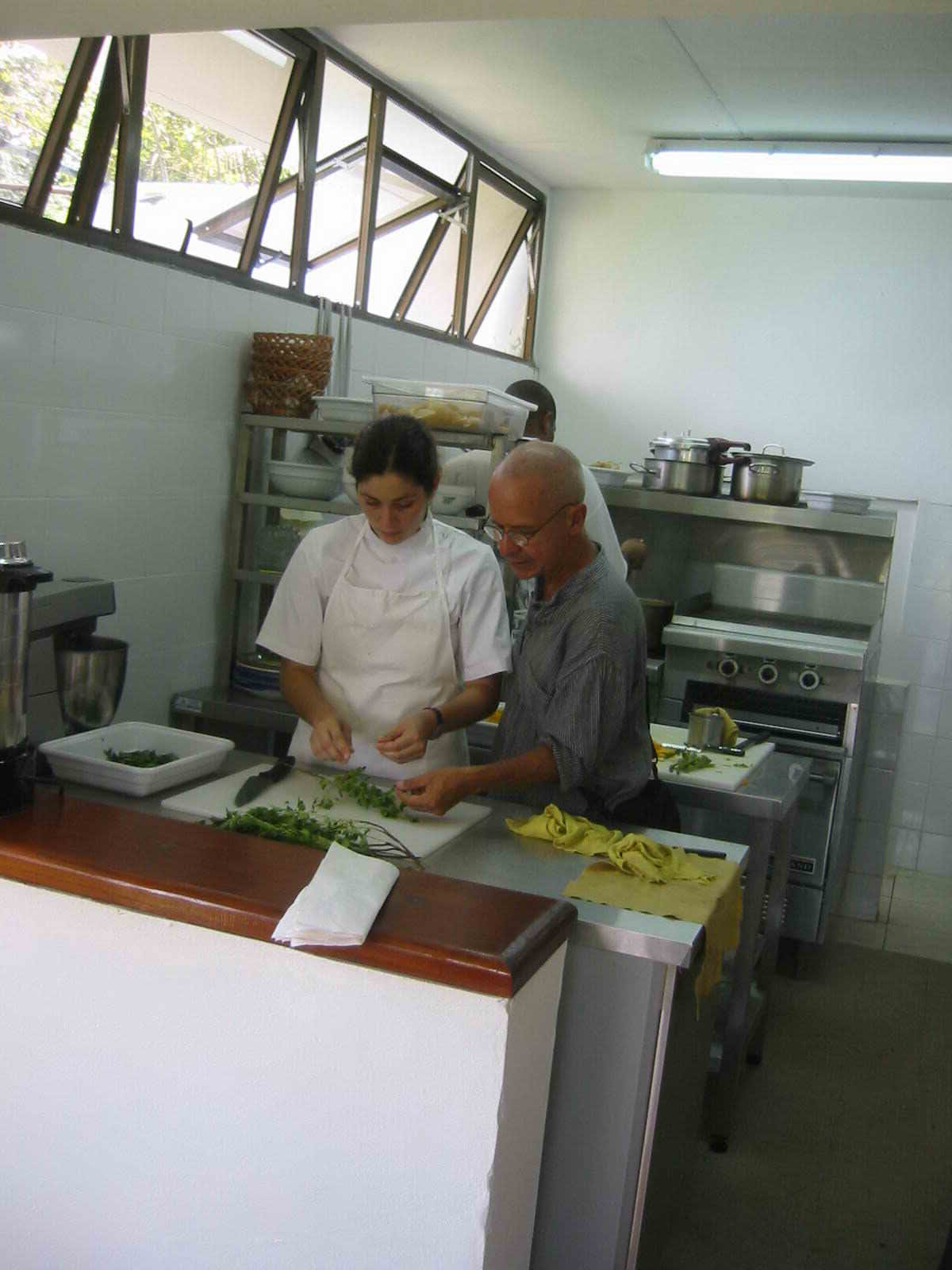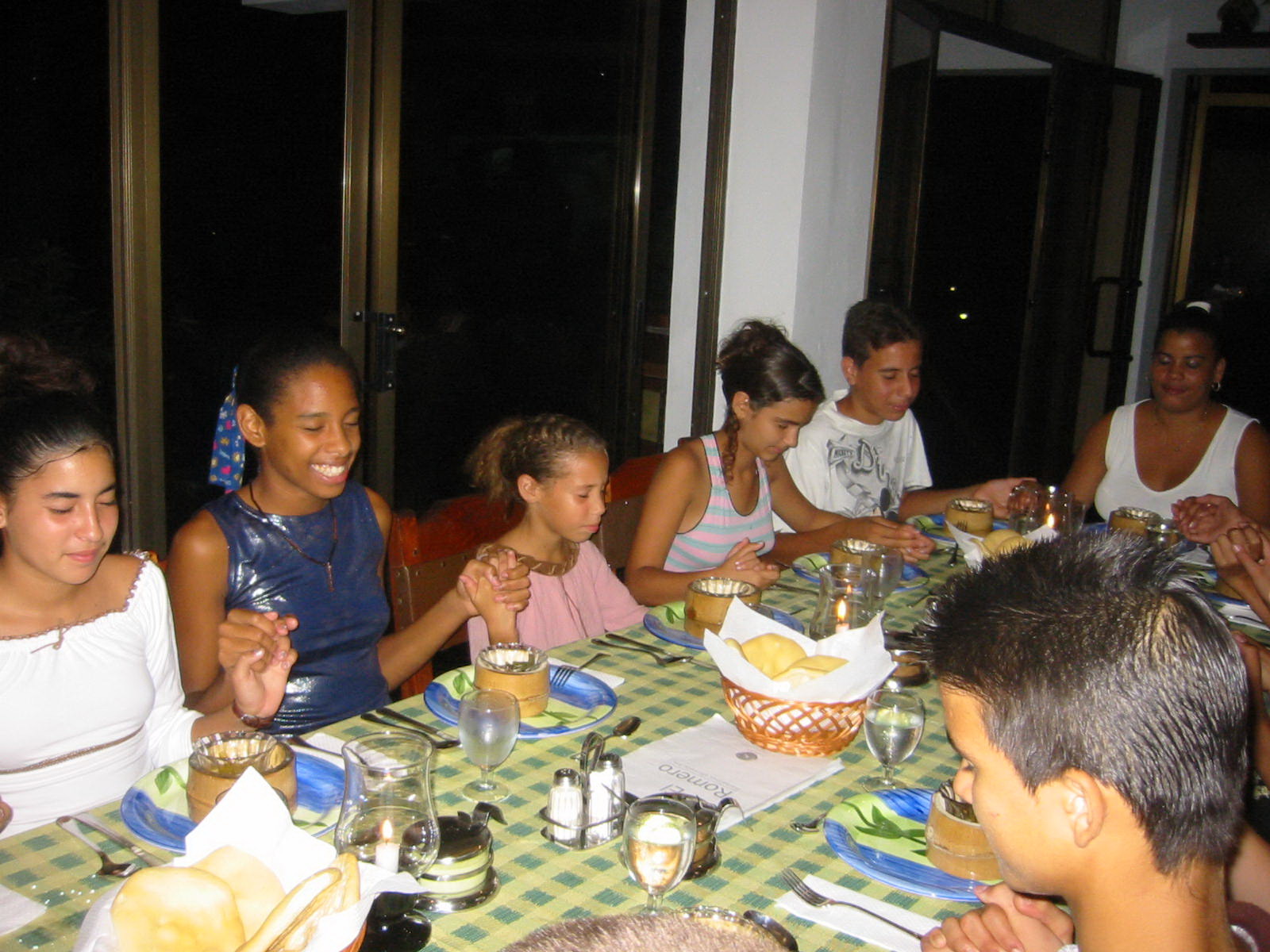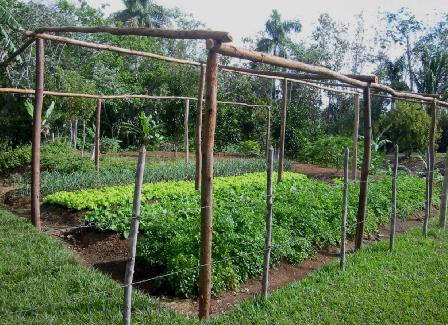A “Crazy” Uncle Got Tito Thinking
Yusimi Rodríguez

HAVANA TIMES, May 11 — “Let live the cows, chickens, fish and all our relations.” This is the slogan of Eco-Restaurant “El Romero”, an ecological restaurant located in the Las Terrazas community of Pinar del Rio Province. It promotes healthy food, natural and ecological cooking, organic farming and sustainable production.
Tito Núñez is the Executive Chef and General Manager. Perhaps some remember him from the Pasaje a lo Desconocido (Travels to the Unknown) program on Cuban TV, where he was interviewed about the vegetarian diet. Others may have eaten at the Eco-Restaurant “Bamboo” in the Japanese Garden of the National Botanical Garden, which he founded in 1991, amid the Special Period crisis, along with consultants from the Culinary Association.
The place became famous in part because of a salad served there made from the petals of what is known in Cuba as the marpacifico flower. It is also known as the Mexican rose or panatela. Although the flower has nutritional and medicinal properties, it has typically been used only ornamentally in Cuba.
Tito Nunez is an extremely active man with a tight schedule. After speaking by telephone on several occasions, I managed to finally talk with him in person and he squeezed me in for an after-hours interview at his home.
Everyone refers to you as Engineer Tito. In what type of engineering do you hold a degree?
I’m an Industrial Engineer, although I first studied several years of design.
How did you become a vegetarian?
Two things. One, I didn’t like to kill animals. Two, I suffered from 12 illnesses in adolescence due to my poor eating habits. At home we ate meat every day. We raised animals. Meat and milk were readily available. I also had a vegetarian uncle who everyone in the family mocked. They said he was crazy because he only ate oranges. He was the last to die of eleven siblings. When I worked with Dr. Orfilio Pelaez, a prominent Cuban ophthalmologist, I met many of his patients who were vegetarians. They showed me the path.
So it was easy to give up meat; you didn’t have any problems?
Frankly, yes. Remember that we were used to eating meat in our home. There is also a myth that if you stop eating it, you’ll die. My father was a doctor and never approved of the vegetarian diet. The only reference I had in my family was my uncle who everyone told me was crazy. And you know how much attention is paid to crazy people. I was afraid that something would happen to me. I counted the days I went without ingesting meat: one day, a week, a month, and now it has been about twenty years since I eliminated it entirely.
And the result?
JOY. Allergies and skin imperfections disappeared. Other complaints were erased. I began to feel very well. I had already been diagnosed with diabetes before the diet change, but now I live without the discomfort that I felt before. I don’t suffer the hypoglycemia like I did before and I feel perfectly fine.
However, some theories suggest that eating meat was an important step in the evolution from ape to man.
No one can prove that scientifically. In fact, if we were all vegetarians we might not be damaging the planet the way were are. There wouldn’t be so many species in danger of extinction. So many freezers would not be necessary. It would be another world.
You have become a specialist in not only vegetarian food, but also ecological cooking. How did that come about; what did you study?
Well, I am self-taught. There are no vegetarian cooking schools, per se, anywhere that I know of. I have read all the literature at my disposal on Cuban and international vegetarian food, from the classic books of Edward Baltzer and Emilia Monet, for example, to the most recently published. I also worked and studied at the restaurant, “Millennium”, a vegan restaurant in San Francisco for over a month. Even on my time off, I went to the restaurant to learn how they did everything.
Tito, you were the soul of the Eco- Restaurant of the Botanical Garden for eight years. Diners could always expect to see you there. But then suddenly you disappeared …
Well, I had to do other things. I wanted to try other projects. I’ve also been studying constantly.
And how did you end up in Las Terrazas? How did the idea of a green restaurant there come about?
First let me say that I am not at the center of this project at all and that what has been done in Las Terrazas is more than a restaurant for tourists. This area was deforested after the French colonists cultivated coffee here for much of the nineteenth century. Starting in 1967, Architect Osmany Cienfuegos led a program of social and rural development.

More than six million seedlings have been planted and a beautiful town has been built over the years. This has earned Las Terrazas UNESCO recognition as a biosphere reserve since 1985. When I arrived there in 1997, I found a community with schools, teachers, and doctors. But other sources of employment were needed. Tourism provided an opportunity. Marcia Leiseca had contacted me three years earlier in the Botanical Garden about teaching classes to students in the trade school. There was also concern about the eating habits of the residents. They needed to be introduced to new perspectives.
Students began coming once a week to eat at the Eco-Restaurant in the Botanical Garden and they loved it. Parents and professors came too. I started to teach a workshop on natural food and nutritional culture. The idea was to motivate young people to support a green restaurant, because we already had the idea to open it. I want to tell you that the current administrator was one of the first students from back then.
We designed the first sketches for the restaurant with a group of students from the Industrial Design Institute and two graduates of the Design Institute of Paris. I don’t remember if it was in ‘97 or ‘98. We worked on it for months. It was a learning experience. Everything was going to be very ecological. We were even going to build on pilings so that the cement would not damage the earth.
However, it couldn’t come to fruition and time passed. I continued working in other places until one day I ran into Marcia again and she told me that the restaurant was ready and we could start whenever I wanted. That was in 2003. I had to find the equipment because we only had the place, but the restaurant began operating on September 1 of that year.”
How many dishes are on the menu?
More than sixty items that are made entirely in-house, including teas, juices, and salads, both cooked and uncooked plates with vegetables and fruits that are, as I told you, grown right there with organic farming techniques. There we bake whole grain breads, cakes, and other baked goods. Many of these dishes are served in containers made from cane stalks, gourds, coconuts or bamboo branches. We do not offer cigarettes or alcoholic beverages.
Everything is grown there?
Eighty percent of the vegetables and fruits are grown there. But, for example, rice, beans, and pineapple come from outside sources.
How many people work there?
Eleven: including a cook, a health specialist, an administrator, two entremettiers, and a permaculturist— because almost all the vegetables and fruits that are served there are collected or cultivated there.
You all live in Las Terrazas?
The two entremettiers and I are the only ones who do not live in Las Terrazas.
So, this restaurant has also been a source of jobs for the community.
Yes, but the main objective of this restaurant is to prevent the suffering and slaughter of animals and to promote a nutritional culture; a healthy diet; natural, ecological, and scientific cooking; sustainable production; recognition and use of nutritional plants and spices; to develop the use of local resources and to achieve a harmonious and clean environment.
Have the eating habits of the Las Terrazas residents changed. Do they enjoy the food in this restaurant?
I want you to know that the community residents are the first to recommend “El Romero” as one of the best places to eat. Each day the restaurant has up to two tables available for community residents with a prior reservation and payment in local currency [instead of the hard currency that tourists pay in]. They can book at any time of year and eat there the day they wish and as often as they want. We’ve hosted celebrations and family meals. I can say that now they have a positive and fair opinion of the diet promoted by the Eco-Restaurant.
You promote a vegetarian diet mainly to avoid animal suffering. But what would be the option for the Eskimos and people living in cold, inhospitable regions where cultivation is impossible?
I think an Eskimo could answer that better than me. I would have moved to a warmer place where I could grow vegetables a long time ago. Of course, they are adapted to live in that environment and, surely, they are fine there. That’s the main thing. Life should always be in search of balance. Luckily for the planet, those populations are comparatively small and, although they fish, they do it on a small scale. That is, they don’t obliterate ecosystems with invasive or destructive technologies. Personally I do not like to kill animals, but in their case, they don’t have many alternatives. Perhaps algae or eggs. The truth is that it makes my hair stand on end just thinking about having to live in a cold place.
There are also plant lovers who believe that killing them is as unethical as killing animals because they too are living beings.
A plant does not die from eating its fruit. I’ll give you an example: when you take a mango from a tree, it does not die. Furthermore, after consuming it, the seed remains with the potential of sprouting another tree. Each seed is a potential new plant. But when you sacrifice an animal, you kill not only it, but also the possibility of offspring.

To give another example, lettuce and carrots are not wild in nature. They have been domesticated by man. If lettuce is not consumed when it’s ready, its leaves disappear. The same goes for the fruit of a tree. It falls and then rots. Even many wild plants found can be used without destroying them. They have the ability to regenerate. Look, when fattening up animals to eat, you have to devote huge tracts of land to feeding them. So, that land cannot be used to plant trees, which we need to purify the air.
Tito, you told me awhile ago that you worked on other projects.
Yes, I participated in the creation of a healthy lunchroom at the Carlos J. Finlay Institute in 1998. I also proposed a vegetarian area at La Ferminia restaurant between 2001 and 2002. I had to bite the bullet and work among the pots where the rest of the food was being prepared. You know I don’t like the feeling or the odors. But the project worked and the clients were satisfied. It lasted nearly two years.
During that time I taught a workshop on vegetarian food for the Palmares Restaurant Company. Also in Tarará [in east Havana] we attempted to launch the project Cun-Cun Las Nieves, with a green kitchen adjusted to fit beach demands. We had to start by preparing the completely overgrown land so we could cultivate vegetables for the dishes were going to make. It was a difficult project, but I managed to motivate a group of farmers and we were able to open the restaurant. It worked for about a year, but the expected tourists never came. There were other problems too so we finally closed the restaurant.
What now?
I’m working on a project for the International Film School of San Antonio de los Baños. There are other places from which I receive requests and concerns. Of course, I will never say NO. I will try to counsel, advise and help as much as I can.
Have you published a book containing your knowledge?
There is a multimedia CD called El Romero available in Las Terrazas. It contains recipes, techniques and helpful information.
You said you taught classes at the trade school in Las Terrazas to train the restaurant staff. Have you continued training the younger generation?
Of course. All these years I’ve continued hosting an interest group made up of students from the “República Oriental de Uruguay” secondary school. We hold meetings and workshops in the kitchen of Eco-Restaurant. They also work in the garden so they can interact and learn about the plants used in cooking. They have two graded activities per year: one, cooking for an elderly facility called the Grandparents Circle, and the second, making a meal for a group of farmers on Earth Day. This year they are working to design a solar cooker from recycled materials. We’ll see what comes out of that educational adventure.
Then you feel confident that others will carry on after you.
I am sure of it.

A lovely portrait of Tito. Thanks to Yurimi Rodriguez for this terrific interview.
Granma had a nice portrait of him in 2002, which has been translated and posted to the Internet, along with a sample of the menu and some additional articles about vegetariasm in Cuba:
VEGETARIANISM A LO CUBANO:
http://www.walterlippmann.com/valc.html